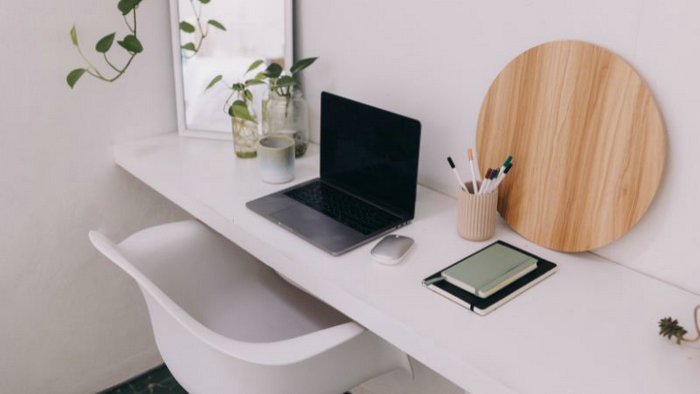
When setting up an office space, whether it’s a busy corporate environment or a cozy corner of your home, understanding the dimensions of an office table is crucial. Your desk serves as your main workstation and its size can impact your productivity and comfort.
Key Takeaways:
Common size dimensions for office desks
- Width
Standard office desk width is typically 60 inches, with a range of 48-72 inches being common.
Executive desks also tend to be wide, around 60 inches or more. - Depth
The standard depth for most office desks is around 30 inches. This allows enough room for office necessities without taking up too much space.
Some executive desks may be deeper, around 36 inches, to accommodate more storage. - Height
Standard desk height is usually 29-30 inches.
Standing desk height ranges from 38-50 inches depending on the user’s height.
Drafting tables are often around 32 inches high.
Overview of the Types of Desk
When selecting the perfect desk for your office, there are various types you can choose from depending on your needs and the intended use. Each desk type brings its own set of dimensions and functionalities tailored to different tasks and office layouts.
Standing Desksoffice
Standing desks allow you to work while standing up, which can help improve posture and reduce the discomfort from prolonged sitting. They typically range in height to accommodate standing adults, with adjustable models that can convert between sitting and standing heights.
Sitting Desks
Sitting desks are the standard desks used in many office environments. Their heights are generally around 30 inches to fit the average sitting adult. Sitting desks come in a variety of widths and depths, with common dimensions being 48, 60, and 72 inches wide by 24, 30, and 36 inches deep.
Executive Desks
With executive desks, you get a larger work surface, often measuring 105 to 130 inches long by 96 to 123 inches deep to accommodate meetings with multiple people. These desks are designed for expansive home office designs and formal office layouts.
Computer Desks
Computer desks have features like keyboard trays and cable management. They’re built to hold a computer monitor and accessories comfortably, often 60 inches wide with sufficient depth for comfortable usage, around 30 inches.
Writing Desks
Writing desks provide a simple, flat surface ideal for writing and paperwork, typically without the extra storage or features of computer desks. Sizes vary, but they offer enough surface for spreading out documents and often have a minimalist design fitting for home office spaces.
Corner Desks
Corner desks refer to desks that are designed to fit into the corner of a room in order to maximize usable space. They come in a variety of styles and often feature storage elements like shelves and drawers. Corner desks are ideal for small spaces like home offices or bedrooms due to their space-saving shape. They allow you to make the most of corner areas and can provide an ergonomic workspace while maintaining access to items without needing to get up. Key benefits are the ability to maximize usable space and storage in a small room.
Standard Desk Dimensions

When choosing your ideal desk, it’s important to consider the standard dimensions to ensure you have a comfortable workspace that fits your environment.
Desk Height
The standard desk height is typically 30 inches tall. This height is a comfortable level for most people while sitting and accommodates standard office chairs. Remember to provide enough clearance for your legs, aiming for at least a few inches between your thighs and the desk’s underside.
Desk Width
Desk widths vary based on the type and purpose, but the standard width ranges from 48 to 72 inches. This gives you sufficient space to accommodate a computer, documents, and other desk essentials without feeling cramped.
Desk Depth
For desk depth, standard dimensions fall between 24 and 36 inches. A deeper desk allows for more space for monitors and work materials, while ensuring you can reach everything comfortably from your seated position.
Ergonomics and Comfort
When designing your workspace, it’s essential to consider how your office furniture affects your comfort and health. Ergonomics focuses on ensuring that your environment fits you, preventing discomfort and promoting well-being.
Posture and Sitting
Your posture plays a crucial role in maintaining comfort throughout the workday. An ergonomically designed sitting desk should enable you to keep your feet flat on the ground, with your thighs parallel to the floor. Make sure your desk height allows your elbows to rest comfortably at a 90-degree angle when typing to avoid strain.
- Correct Sitting Posture at a Desk:
- Feet flat on the floor or on a footrest
- Thighs parallel to the floor
- Elbows at a 90-degree angle
- Shoulders relaxed
- Back supported by the chair
Desk Chairs and Space
Choosing the right desk chair is equally important for maintaining ergonomics at your workstation. Your chair should come with adjustable height to match your desk and allow your knees to be at right angles. Additionally, adequate space under your desk is required to prevent crowding of your legs and feet, ensuring you have enough room to move and stretch.
- Key Features of an Ergonomic Office Chair:
- Adjustable height
- Lumbar support for your lower back
- Armrests at a height where your shoulders remain relaxed
- Swivel and tilt functions for easy movement
Remember, comfort and ergonomics go hand in hand. Adjust your posture and workspace to avoid long-term discomfort, and create a more productive and stress-free environment.
Workspace Optimization

Optimizing your workspace effectively can lead to enhanced productivity and a more comfortable working environment. By selecting the right desk and storage solutions, you will maximize the available space while ensuring all your equipment and essentials are within reach.
Efficient Use of Space
To make the most of your office area, measure your available space carefully. Here’s a strategy to ensure you use space efficiently:
- Choose the right desk style: L-shaped desks can offer more surface area while taking up less room.
- Consider the space-saving model: If your work primarily involves a computer monitor, a floating desk or one with a compact footprint can free up floor space.
- Opt for multipurpose furniture: Desks with built-in shelves can serve multiple functions, saving you space and keeping your work area tidy.
Desk Storage Solutions
Strategic desk storage solutions are essential for maintaining an organized workspace. Here’s how to incorporate storage effectively:
- Incorporate built-in storage: Opt for desks with drawers or cabinets to keep supplies concealed and accessible.
- Use vertical space: Install shelves above your desk to store books and equipment, making use of upward space often overlooked.
- Select ergonomic accessories: Ensure items like your keyboard and mouse are within easy reach and your monitor is at eye level to reduce strain.
Desk Features and Accessories

When selecting the perfect office desk, features and accessories can transform your workspace not only aesthetically but also in terms of functionality and efficiency.
Built-In Options and Add-ons
Your ideal desk caters to your professional needs with built-in options and add-ons such as shelving, drawers, or pull-out trays for additional storage. Make sure to look for a utility workstation if your work requires an expansive setup. To maintain a clean look and maximize space, consider desks with hidden compartments or those designed with cable management systems to organize your cords neatly.
- Shelving: Useful for books, manuals, or decorative items.
- Drawers/Pull-out Trays: Essential for keeping office supplies or documents tidy.
- Cable Management: Keeps your cables neatly tucked away.
Choosing a Desk for Your Home Office
When you’re setting up your home office, the desk is the centerpiece of your workspace. It’s essential to choose one that fits your space perfectly and suits your work style.
Space Constraints and Desk Size
Assessing your home office space is crucial before deciding on a desk. Here’s a brief guide on standard desk sizes:
- Small Desk: Ideal for compact spaces, typically measures between 40-48 inches wide and 20 inches deep.
- Medium Desk: Offers more workspace, ranging from 50-62 inches in width and 24 inches in depth.
- Large Desk: For spacious home offices, standard sizes span from 65-80 inches wide and up to 30 inches deep.
Consider if the room allows for an L-shaped desk, which can provide ample surface area while making efficient use of corner space. If standard sizes don’t fit, build your own desk that caters to your specific measurements. For example, whole seller like Hoolnn offer customizable desk components that can be tailored to fit any home office space.
Design and Material Considerations
The design and material of your desk impact not only aesthetics but also function and durability. Here’s a quick overview of material options:
- Wood: Classic and sturdy, available in a range of finishes.
- Metal: Offers a modern look and typically provides strong support.
- Glass: Glass desks have a sleek appearance but require more cleaning to maintain.
While considering materials, think about the desk’s functionality too. Do you need drawers for storage, or will a simple tabletop suffice? Ensure that the desk’s height is around 30 inches, which is comfortable for most users. Keep in mind that the design should complement the overall style of your home office.
Desk Selection for Businesses and Professionals
When selecting the right desk for your business or professional space, focus on the specific desk size and functionality to meet your office needs and ensure the comfort and efficiency of employees, whether they’re working remotely or in a single office workstation.
Multi-person Desks and Workstations
For multi-person desks and larger collaborative spaces, the layout and desk configuration can significantly impact productivity. A multi-person desk setup should cater to each individual’s workspace while facilitating easy communication and collaboration.
Consider the following when choosing multi-person desks:
- Workstations should be spacious enough for each person, typically necessitating larger desk sizes.
- For efficiency, ensure that there’s adequate storage and workspace for each user without overcrowding.
- Remote work and work from home settings might require adaptable setups that can comfortably fit into a home environment and support professional needs.
Whether outfitting an office for your team or setting up a single office workstation, the physical dimensions and the layout of the desks are pivotal to creating a conducive work environment.



